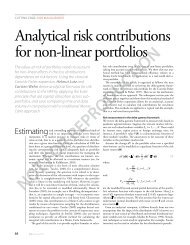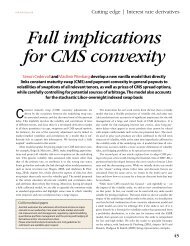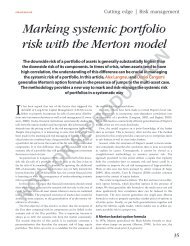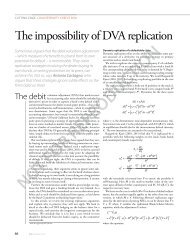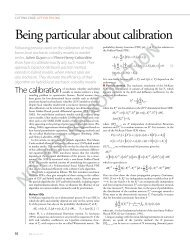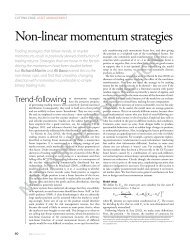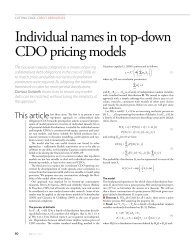Modeling drawdowns and drawups in financial markets - Risk.net
Modeling drawdowns and drawups in financial markets - Risk.net
Modeling drawdowns and drawups in financial markets - Risk.net
You also want an ePaper? Increase the reach of your titles
YUMPU automatically turns print PDFs into web optimized ePapers that Google loves.
58<br />
Beatriz Vaz de Melo Mendes <strong>and</strong> V<strong>in</strong>icius Ratton Br<strong>and</strong>i<br />
( ) ↑<br />
⎧ yγ<br />
−1<br />
ξ<br />
⎪<br />
1− 1+<br />
ξ , if ξ 0<br />
ψ<br />
G( γ, ξ, ψ;<br />
y)<br />
= ⎨<br />
yγ<br />
⎪ −<br />
ψ<br />
⎩⎪<br />
1−<br />
e , if ξ=0<br />
where γ > 0, <strong>and</strong> ψ > 0 is a scale parameter. We observe that the GPD (2) may be<br />
obta<strong>in</strong>ed from (3) by lett<strong>in</strong>g γ = 1, <strong>and</strong> that the stretched exponential corresponds<br />
to ξ = 0. As po<strong>in</strong>ted out by the referee, fitt<strong>in</strong>g the MGPD to Y is equivalent to<br />
tak<strong>in</strong>g a Box–Cox transformation of Y, <strong>and</strong> model<strong>in</strong>g Y γ us<strong>in</strong>g equation (2). We<br />
chose to keep the r<strong>and</strong>om variable Y, the drawdown or drawup, <strong>and</strong> to fit the large<br />
family MGPD, which allowed us to pursue st<strong>and</strong>ard log-likelihood nested statistical<br />
tests.<br />
The MGPD density function is given by<br />
−1− ξ<br />
⎧<br />
⎪<br />
g( γ, ξ, ψ;<br />
y)<br />
( ξψ yγ ξ ) ψ γ yγ<br />
=<br />
1+ −1 −1 −1,<br />
if ξ ↑ 0<br />
⎨<br />
e− ψ−1y γ<br />
ψ−1γ γ −1<br />
⎩⎪<br />
y ξ<br />
( ) , if =0<br />
The left side of Figure 2 illustrates the flexibility of the MGPD density accord<strong>in</strong>g<br />
to the shape ξ, the scale ψ, <strong>and</strong> the “modify<strong>in</strong>g” γ parameters. In this plot<br />
ξ = 0.6, ψ = 3, <strong>and</strong> γ = 0.5, 1.0, 1.5. When γ < 1 the densities are strictly decreas<strong>in</strong>g<br />
with heavier tails; the GPD is recovered by sett<strong>in</strong>g γ = 1; γ > 1 <strong>in</strong>duces concavity.<br />
The MGPD can accommodate several distribution shapes <strong>and</strong> may present fatter<br />
tails than the stretched exponential (at the right-h<strong>and</strong> side).<br />
Summariz<strong>in</strong>g, the follow<strong>in</strong>g three constra<strong>in</strong>ed models are obta<strong>in</strong>ed from the<br />
full model MGPD(γ, ξ, ψ): (1) The MGPD(γ, 0, ψ), or the stretched exponential<br />
(SE); (2) The MGPD(1, ξ, ψ), or the GPD; (3) The MGPD(1, 0, ψ), or the unit<br />
exponential distribution.<br />
2.2 Estimation <strong>and</strong> tests<br />
We fit by maximum likelihood the full model MGPD(γ, ξ, ψ) <strong>and</strong> the three constra<strong>in</strong>ed<br />
models to the samples y 1 , y 2 ,…, y n , conta<strong>in</strong><strong>in</strong>g n <strong>drawups</strong> or absolute<br />
value of <strong>drawdowns</strong>. Other estimation methods may be found <strong>in</strong> the literature,<br />
such as the method of moments (see Embrechts, Klüppelberg, <strong>and</strong> Mikosch, 1997,<br />
or Bayesian methods – Reiss <strong>and</strong> Thomas, 1999). We chose to estimate by maximum<br />
likelihood because these estimates possess good (asymptotic) properties <strong>and</strong><br />
allow the use of well-known statistical tests.<br />
The st<strong>and</strong>ard likelihood ratio test is used to discrim<strong>in</strong>ate between the nested<br />
models. St<strong>and</strong>ard errors of the estimates may be obta<strong>in</strong>ed from the <strong>in</strong>verse of the<br />
observed <strong>in</strong>formation matrix. Confidence <strong>in</strong>tervals based on simple bootstrap<br />
techniques are also easily obta<strong>in</strong>ed.<br />
Goodness of fits may be checked graphically by means of QQ-plots. We plot<br />
the quantiles from the fitted models aga<strong>in</strong>st the sorted data. We formally test the<br />
goodness of fit us<strong>in</strong>g the Kolmogorov test (Bickel <strong>and</strong> Doksum, 1977) whose test<br />
statistic is D n = max i max{i⁄n – F 0 (y (i) ), F 0 (y (i) ) – (i–1) ⁄n}, where y (1) ≤ y (2) ≤ … ≤<br />
URL: www.thejournalofrisk.com Journal of <strong>Risk</strong><br />
(3)<br />
(4)




